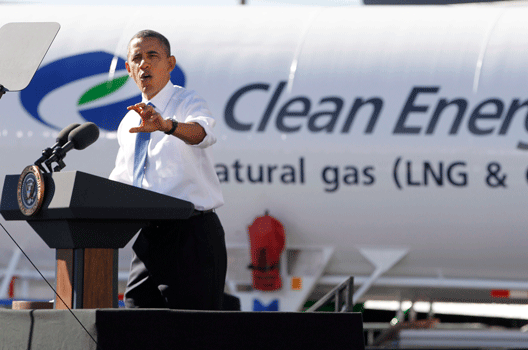 The shale boom and the newfound abundance of natural gas have put the United States on track to become the world’s third-largest exporter of liquefied natural gas (LNG). This new role in the global market has the potential to benefit both the United States and its worldwide partners. It will make the natural gas trade less political—primarily by reducing the opportunity for exporters to wield their supplies as an “energy weapon” against importers on the international stage—and displace coal by serving as a less polluting “bridge fuel” in the transition to renewable energy.
The shale boom and the newfound abundance of natural gas have put the United States on track to become the world’s third-largest exporter of liquefied natural gas (LNG). This new role in the global market has the potential to benefit both the United States and its worldwide partners. It will make the natural gas trade less political—primarily by reducing the opportunity for exporters to wield their supplies as an “energy weapon” against importers on the international stage—and displace coal by serving as a less polluting “bridge fuel” in the transition to renewable energy.
Maarten Wetselaar, integrated gas and new energies director at Royal Dutch Shell, has identified two deciding factors for the ongoing viability of the LNG industry, “the twin pillars of cost and policy innovation.” It is on the second pillar that the US government can make the most difference, and the regulatory support for offshore LNG is the most compelling target for reform.
A predictable and replicable approval process would help solve one of the key complexities of developing individual export projects. On the one hand, a project must organize its operations: secure its inputs, outline a feasible construction plan, and line up credible offtake agreements.
On the other hand, it must navigate a difficult regulatory process. Because each of these tasks hinges on the success of the others, any uncertainty multiplies the risk. Government support for and incremental reform of the offshore approval process would strengthen the entire framework by lessening the regulatory fog. The prospects for improvement are positive. The offshore process is already less onerous and more straightforward than the onshore one, therefore any encouragement from the government would promote an underutilized opportunity to increase the number of LNG export projects. Additionally, by helping a currently underway application, regulators could create a clear precedent and case study for future applicants.
The current LNG export approval process, which relies on two government entities, has been proven successful, if not dependable. The first entity involved in the process is the US Department of Energy (DOE), which reviews export applications for countries that do not have free-trade agreements with the United States, and determines whether such projects are consistent with the public interest. This review can be opaque, but both the Senate and the House of Representatives have passed separate bills to both expedite and offer more clarity in the approval process. They are currently working to reconcile these bills into one set of regulations. The most important shared provision would create a window of time for the DOE to act following environmental approval. This would provide clearer timing expectations for applicants.
The second entity is the Federal Energy Regulatory Commission (FERC), which authorizes construction and operation of the facilities in question, and conducts an environmental review. As proposals for LNG exports have increased, the queue for approval has lengthened. At the moment, fifteen proposed terminals either had pending applications or were still in the pre-filing phase.
There is, however, a way of avoiding the FERC chokepoint. Any LNG project located in federal waters (rather than onshore or state waters) sidesteps FERC and falls primarily, per the Deepwater Port Act, under the joint jurisdiction of the Marine Administration (MARAD) of the Department of Transportation and the US Coast Guard. MARAD reviews the financial and operational aspects of the project while the Coast Guard handles the safety, security, and environmental aspects.
Unlike FERC approval, which can take up to three years, the MARAD/Coast Guard process offers a defined 356-day path from application submission to Record of Decision. Most importantly, only one project is currently awaiting approval. This Gulf of Mexico facility, Delfin LNG, has the backing of the Korea Development Bank and is, as of July 2016, under environmental review. Its success can be both a strong policy precedent and an argument for the practicality of the MARAD/Coast Guard process, as well as a case study for prospective LNG exporters evaluating project options.
Some positive developments in the offshore permitting process are already underway. The Coast Guard has proposed changes that will better define both MARAD and its own responsibilities while also clarifying application requirements. One proposed change would more clearly outline the full scope of required data which will cut delays caused by additional requests for information. This trend is encouraging, but the example of a successfully-permitted offshore facility will be the most effective incentive to give investors the confidence to underwrite new developments.
A more easily navigable regulatory progress is only half of the motor for LNG export expansion. The other half, and logical next step, is improving project-level economics to make funding more appealing to investors. Here, too, there is cause for optimism. Offshore projects can offer flexibility unmatched by onshore facilities in terms of construction costs, contract duration, pricing, delivery method, and contract structure.
With its role in the global LNG market on the verge of significant growth, the US government can point the way forward and set a clear example by encouraging offshore approval.
Edoardo Saravalle is a Houston-based investment banker. He covers companies in the upstream, midstream, and oilfield services sectors.
Image: US President Barack Obama delivers remarks at a UPS facility in Las Vegas, Nevada, January 26, 2012. Obama used the event to talk about US energy and liquefied natural gas. (Reuters/Jason Reed)
